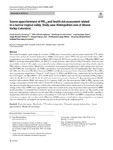Source Apportionment of PM10 and Health Risk Assessment Related in a Narrow Tropical Valley. Study Case: Metropolitan Area of Aburrá Valley (Colombia)

Use este enlace para citar
http://hdl.handle.net/2183/33319Colecciones
- Investigación (FCIE) [1228]
Metadatos
Mostrar el registro completo del ítemTítulo
Source Apportionment of PM10 and Health Risk Assessment Related in a Narrow Tropical Valley. Study Case: Metropolitan Area of Aburrá Valley (Colombia)Autor(es)
Fecha
2023-04-05Cita bibliográfica
Ramos-Contreras, C., Piñeiro-Iglesias, M., Concha-Graña, E. et al. Source apportionment of PM10 and health risk assessment related in a narrow tropical valley. Study case: Metropolitan area of Aburrá Valley (Colombia). Environ Sci Pollut Res 30, 60036–60049 (2023). https://doi.org/10.1007/s11356-023-26710-1
Resumen
[Abstract] This study investigates spatio-temporal variations of PM10 mass concentrations and associated metal(oid)s, δ13C carbon isotope ratios, polycyclic aromatic hydrocarbons (PAHs), total organic carbon (TOC) and equivalent black carbon (eBC) concentrations over a half year period (from March 2017 to October 2017) in two residential areas of Medellín (MED-1 and MED-2) and Itagüí municipality (ITA-1 and ITA-2) at a tropical narrow valley (Aburrá Valley, Colombia), where few data are available. A total of 104 samples were analysed by using validated analytical methodologies, providing valuable data for PM10 chemical characterisation. Metal(oid)s concentrations were measured by inductively coupled plasma mass spectrometry (ICP-MS) after acid digestion, and PAHs concentrations were measured by Gas Chromatography-Mass Spectrometry (GC–MS) after Pressurised Hot Water Extraction (PHWE) and Membrane Assisted Solvent Extraction (MASE). Mean PM10 mass concentration ranged from 37.0 µg m−3 to 45.7 µg m−3 in ITA-2 and MED-2 sites, respectively. Al, Ca, Mg and Na (from 6249 ng m−3 for Mg at MED-1 site to 10,506 ng m−3 for Ca at MED-2 site) were the major elements in PM10 samples, whilst As, Be, Bi, Co, Cs, Li, Ni, Sb, Se, Tl and V were found at trace levels (< 5.4 ng m−3). Benzo[g,h,i] perylene (BghiP), benzo[b + j]fluoranthene (BbjF) and indene(1,2,3-c,d)pyrene (IcdP) were the most profuse PAHs in PM10 samples, with average concentrations of 0.82–0.86, 0.60–0.78 and 0.47–0.58 ng m−3, respectively. Results observed in the four sampling sites showed a similar dispersion pattern of pollutants, with temporal fluctuations which seems to be associated to the meteorology of the valley. A PM source apportionment study were carried out by using the positive matrix factorization (PMF) model, pointing to re-suspended dust, combustion processes, quarry activity and secondary aerosols as PM10 sources in the study area. Among them, combustion was the major PM10 contribution (accounting from 32.1 to 32.9% in ITA-1 and ITA-2, respectively), followed by secondary aerosols (accounting for 13.2% and 23.3% ITA-1 and MED-1, respectively). Finally, a moderate carcinogenic risk was observed for PM10-bound PAHs exposure via inhalation, whereas significant carcinogenic risk was estimated for carcinogenic metal(oid)s exposure in the area during the sampling period.
Palabras clave
Particulate matter
Metal(oid)s
δ13C carbon isotope ratios
Source apportionment
Health risk assessment
Metal(oid)s
δ13C carbon isotope ratios
Source apportionment
Health risk assessment
Descripción
Financiado para publicación en acceso aberto: Universidade da Coruña/CISUG
Versión del editor
Derechos
Atribución 4.0 Internacional
ISSN
1614-7499






